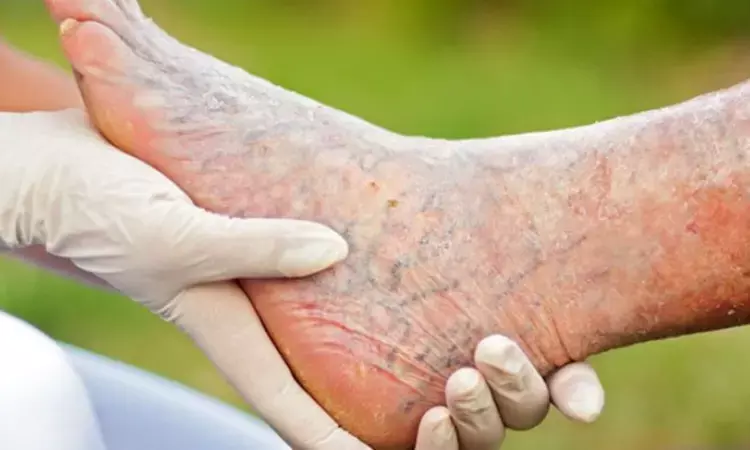- Home
- Medical news & Guidelines
- Anesthesiology
- Cardiology and CTVS
- Critical Care
- Dentistry
- Dermatology
- Diabetes and Endocrinology
- ENT
- Gastroenterology
- Medicine
- Nephrology
- Neurology
- Obstretics-Gynaecology
- Oncology
- Ophthalmology
- Orthopaedics
- Pediatrics-Neonatology
- Psychiatry
- Pulmonology
- Radiology
- Surgery
- Urology
- Laboratory Medicine
- Diet
- Nursing
- Paramedical
- Physiotherapy
- Health news
- Fact Check
- Bone Health Fact Check
- Brain Health Fact Check
- Cancer Related Fact Check
- Child Care Fact Check
- Dental and oral health fact check
- Diabetes and metabolic health fact check
- Diet and Nutrition Fact Check
- Eye and ENT Care Fact Check
- Fitness fact check
- Gut health fact check
- Heart health fact check
- Kidney health fact check
- Medical education fact check
- Men's health fact check
- Respiratory fact check
- Skin and hair care fact check
- Vaccine and Immunization fact check
- Women's health fact check
- AYUSH
- State News
- Andaman and Nicobar Islands
- Andhra Pradesh
- Arunachal Pradesh
- Assam
- Bihar
- Chandigarh
- Chattisgarh
- Dadra and Nagar Haveli
- Daman and Diu
- Delhi
- Goa
- Gujarat
- Haryana
- Himachal Pradesh
- Jammu & Kashmir
- Jharkhand
- Karnataka
- Kerala
- Ladakh
- Lakshadweep
- Madhya Pradesh
- Maharashtra
- Manipur
- Meghalaya
- Mizoram
- Nagaland
- Odisha
- Puducherry
- Punjab
- Rajasthan
- Sikkim
- Tamil Nadu
- Telangana
- Tripura
- Uttar Pradesh
- Uttrakhand
- West Bengal
- Medical Education
- Industry
Open bypass for infrapopliteal revascularization lowers major adverse limb events, suggests study

A recent study published in the Journal of Vascular Surgery found that among the patients having suitable single segment great saphenous vein who undergo infrapopliteal revascularization for chronic limb threatening ischemia (CLTI), open bypass surgery was associated with a lower incidence of major adverse limb event (MALE) or death and less significant amputation than endovascular treatments. This study by Kristina Giles and colleagues compared the BEST-CLI patients with severe infrapopliteal disease who received open tibial bypass to endovascular tibial procedures.
This comprehensive research focused on a subset of BEST-CLI trial participants who had a suitable single-segment great saphenous vein conduit and significant infrapopliteal disease. These patients were randomized into two groups, where one group had patients who were undergoing open bypass surgery and the other group had patients who were receiving endovascular tibial interventions. The primary outcome measured was the incidence of MALE or all-cause death. MALE included major limb amputation or major re-interventions. The outcomes were assessed using Cox proportional regression models.
The key findings of this study were;
- The analyzed subgroup consisted of 665 patients, where 339 patients were in the tibial endovascular and 326 patients were in the open tibial bypass group procedure group. The main endpoint of MALE or all-cause mortality at 3 years was considerably lower in the surgical group (48.5%) than in the endovascular group (56.7%).
- Mortality rates were 35.5% in the surgical group and 35.8% in the endovascular group. However, the surgical group had a notably lower rate of MALE events at 23.3% when compared to 35.0% in the endovascular group. This included a reduced rate of major re-interventions in the surgical group (10.9%) when compared to the endovascular group (20.2%).
- While the surgical group had fewer above-ankle amputations (13.5%) than the endovascular group, the freedom from above-ankle amputation or all-cause mortality was equal between treatment groups, with 43.6% in the surgical group when compared to 45.3% in the endovascular group. Also, perioperative (30-day) mortality was comparable across treatment groups (2.5% open vs 2.4% endovascular; p=0.93), as it was observed to be 30-day MACE (5.3% open vs 2.7% endovascular; p=0.12).
Overall, when compared to endovascular treatments, open bypass surgery was linked to a reduced risk of major amputation and a lower incidence of MALE or death in patients with acceptable single segment great saphenous veins who had infrapopliteal revascularization for CLTI. Further research is imperative to examine variations in anatomic extent, comorbidities and lesion complexity.
Reference:
Giles, K. A., Farber, A., Menard, M. T., Conte, M. S., Nolan, B. W., Siracuse, J. J., Strong, M., Doros, G., Venermo, M., Azene, E., Rosenfield, K., & Powell, R. J. (2024). Surgery or Endovascular Therapy for Patients with Chronic Limb-threatening Ischemia Requiring Infrapopliteal Interventions. In Journal of Vascular Surgery. Elsevier BV. https://doi.org/10.1016/j.jvs.2024.05.049
Neuroscience Masters graduate
Jacinthlyn Sylvia, a Neuroscience Master's graduate from Chennai has worked extensively in deciphering the neurobiology of cognition and motor control in aging. She also has spread-out exposure to Neurosurgery from her Bachelor’s. She is currently involved in active Neuro-Oncology research. She is an upcoming neuroscientist with a fiery passion for writing. Her news cover at Medical Dialogues feature recent discoveries and updates from the healthcare and biomedical research fields. She can be reached at editorial@medicaldialogues.in
Dr Kamal Kant Kohli-MBBS, DTCD- a chest specialist with more than 30 years of practice and a flair for writing clinical articles, Dr Kamal Kant Kohli joined Medical Dialogues as a Chief Editor of Medical News. Besides writing articles, as an editor, he proofreads and verifies all the medical content published on Medical Dialogues including those coming from journals, studies,medical conferences,guidelines etc. Email: drkohli@medicaldialogues.in. Contact no. 011-43720751


